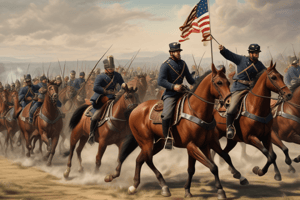Podcast
Questions and Answers
Which event directly contributed to the widening sectional divisions between 1850 and 1856, increasing tensions over the expansion of slavery?
Which event directly contributed to the widening sectional divisions between 1850 and 1856, increasing tensions over the expansion of slavery?
- The Kansas-Nebraska Act and the subsequent violence known as Bleeding Kansas, resulting from the application of popular sovereignty to the slavery issue in these territories. (correct)
- The Compromise of 1850, specifically the admission of California as a free state which upset the balance between free and slave states in the Senate.
- The Dred Scott Supreme Court decision, which denied citizenship to enslaved people and declared the Missouri Compromise unconstitutional.
- The Louisiana Purchase, which doubled the size of the United States and opened vast new territories to potential slavery expansion.
What was the primary reason for the relatively long duration of the Civil War?
What was the primary reason for the relatively long duration of the Civil War?
- Ineffective leadership within the Union army, marked by frequent changes in command and a lack of strategic vision.
- Foreign intervention, particularly the support provided by Great Britain and France to the Confederacy, prolonging the conflict.
- Superior naval technology of the Confederacy, which allowed them to effectively blockade Union ports and disrupt supply lines.
- Lack of decisive early victories by either side, combined with the Confederacy's determination to defend its territory and the Union's initial struggle to effectively mobilize its resources. (correct)
What was a significant, long-lasting consequence of rapid economic growth during the Gilded Age?
What was a significant, long-lasting consequence of rapid economic growth during the Gilded Age?
- Increased government regulation of industries leading to fairer labor practices and wealth distribution.
- Reduction in urban poverty as industrial jobs provided a stable income for all citizens.
- Growing wealth inequality, labor unrest, and the rise of powerful monopolies and trusts. (correct)
- Decline in immigration rates due to increased job security among American workers.
What was a major factor that contributed to the Great Crash of 1929?
What was a major factor that contributed to the Great Crash of 1929?
Why did the Republican Party gain prominence leading up to the 1860 election?
Why did the Republican Party gain prominence leading up to the 1860 election?
Flashcards
Missouri Compromise
Missouri Compromise
The Missouri Compromise (1820) temporarily balanced free and slave states by admitting Missouri as a slave state and Maine as a free state. The Compromise also prohibited slavery in the Louisiana Territory north of the 36°30' parallel.
Kansas-Nebraska Act
Kansas-Nebraska Act
The Kansas-Nebraska Act (1854) repealed the Missouri Compromise, allowing popular sovereignty (allowing residents to vote on slavery) in the territories. This sparked violence and the rise of the Republican Party, opposed to slavery's expansion.
The Rise of the Republican Party
The Rise of the Republican Party
The Republican Party opposed the extension of slavery into the territories and advocated for free labor. They nominated Abraham Lincoln, a moderate candidate, who won the 1860 presidential election.
Secession and the Start of the Civil War
Secession and the Start of the Civil War
Signup and view all the flashcards
Fort Sumter and the start of the Civil War.
Fort Sumter and the start of the Civil War.
Signup and view all the flashcards
Study Notes
Chapter 1: The Origins of the Civil War, 1820-1861
- The issue of slavery was addressed through various compromises between 1820 and 1850, including the Missouri Compromise and the Compromise of 1850.
- Sectional divisions widened between 1850 and 1856 due to events such as the Kansas-Nebraska Act, which heightened tensions about the expansion of slavery. Increased violence and political division also contributed.
- The Republican Party's victory in the 1860 election was aided by their strong stance against the expansion of slavery into new territories. This unified opposition against slavery played a crucial role.
- The Civil War began in April 1861 due to the Confederate attack on Fort Sumter. This act escalated the pre-existing tensions to armed conflict.
Chapter 2: Civil War and Reconstruction, 1861-1877
- The Civil War lasted four years due to a complex set of factors, including the strength and determination of both sides, resourcefulness of both sides, and issues surrounding emancipation.
- The Civil War drastically impacted the U.S. economy, socially, and politically, causing immense suffering, economic disruption, and massive loss of life.
- Reconstruction aimed to rebuild the South and integrate formerly enslaved people into society, but faced significant resistance and challenges. Outcomes varied and fell short of initial intentions.
- Reconstruction's success was limited by persistent racism, political corruption, and economic hardship in the South, ultimately failing to achieve complete equality.
Chapter 3: The Gilded Age and the Progressive Era, 1870s-1920
- The late 19th century witnessed rapid industrialization due to abundant natural resources, new inventions, and a growing labor force. These factors spurred growth.
- Consequences of rapid economic growth included wealth inequality, labor exploitation, corruption, and social unrest.
- Progressive Movement aimed to address issues like poverty, corruption, and industrial abuse. Progressives advocated for reforms, but their popularity varied by region and issue.
- The Progressive Movement had limited success before 1920, with some significant reforms achieved but still with lasting social and economic injustices.
Chapter 4: The Great Crash, the Depression and the New Deal Policies, 1920-1941
- Causes of the Great Crash included speculation in the stock market, easy credit, overproduction, and an uneven distribution of wealth.
- Causes of the Depression included the Crash, bank failures, reduced consumer spending, and a global economic downturn. Impacts included widespread unemployment, poverty, and social unrest.
- Roosevelt's New Deal strategies aimed to combat the Depression via government intervention in the economy. These aimed to provide jobs, financial assistance, and regulate business activity. Their effectiveness is a matter of historical debate.
- Opposition to New Deal policies arose due to concerns about government overreach and potential harm to free markets. This opposition complicated and hindered the implementation of those policies.
Studying That Suits You
Use AI to generate personalized quizzes and flashcards to suit your learning preferences.




